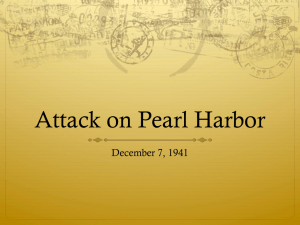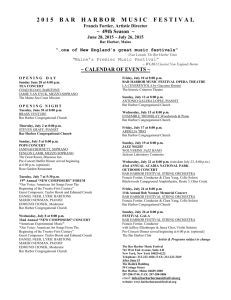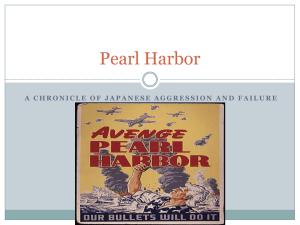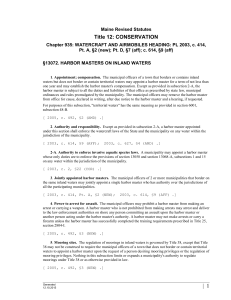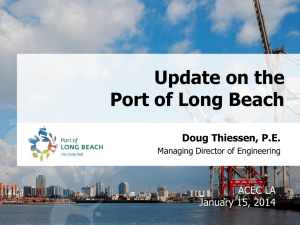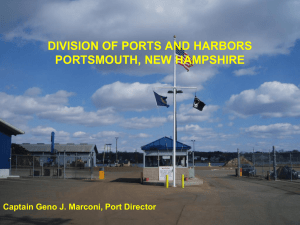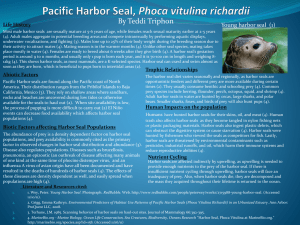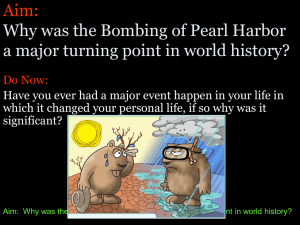KAIST Mobile Harbor (ppt)
advertisement
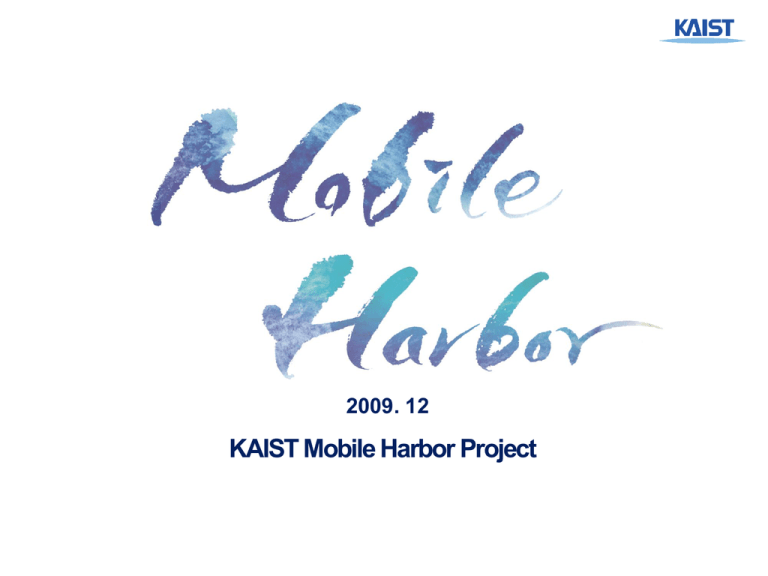
2009. 12 KAIST Mobile Harbor Project 1 /22 What is Mobile Harbor? Novel maritime transport solution that can connect a large containership anchored in the open sea and ports with shallow water • Execute high speed loading and unloading in the wavy open sea • Deploy original, advanced technologies Large Large Containership Containership Large Containership Draft Draft 15m 15m Draft 15m 2 /22 Shallow Shallow or or Congested Congested port port Shallow or Congested port Motivation (1) Continued increase in global container shipping Global container volume increases by ~8% a year Required handling capacity expansion is 4-5 Busan Ports Rise of supersized containerships Global container volume (in million TEU) 3 2/24 /22 Economy of scale leads to increasing number of mega containerships Expansion of Panama canal expedites the trend Need for enhanced port capacity and capability Effective service for large containerships Increased importance of transshipment cargo handling Motivation (2) Environmental damage by port construction CO2 from massive Overland transportation National security Prohibitively large SOC Investment Mobile Harbor 4 /22 Immediate Market Candidate • Limitation in port expansion N. AMERICA EUROPE ASIA • Limitation in port expansion AFRICA • Shallow water • Panama Canal region • Undeveloped port infrastructrure • Port congestion 521/24 /22 OCEANIA S. AMERICA Mobile Harbor Product Line •Product lines to satisfy diverse needs of individual ports • Transfer unit and loading unit Integrated (A type) & Separated (B type) 617/23 /22 Mobile Harbor Product Line A1-250 •Technically most challenging system (stabilization, loading/unloading) • Economical size (small capacity, short range) • Access to shallow water including river, strait A1-1200 • Stable, high-speed container handling (plural cranes onboard) • Serves 8,000~10,000TEU containerships within 48hr • Mid-to-long range transport 718/23 /22 Mobile Harbor Product Line B1 • Uni-body motion • High stability and operational efficiency • Suitable for ports with high container volume B2 • Operating under ship-to-ship docking • Single or plural cranes • Flexibility to achieve optimal system configuration 819/23 /22 Program Structure Original tech. development, basic design, Market analysis, Tech. holding company Univ. (Ulsan Univ, Pusan Nat’l Univ, SNU) Research collaboration Research Institute(KIMM,MOERI,KMI,KR) Collaborative R&D Public companies, Shipping lines (K-Water, Port Authority) Program consulting, Customer Corporates (Hyundai-Wia, DSME, STX Offshore&Shipbuilding, Keumwon Eng.) Detail design & production, Program consulting, Marketing Local government/Overseas (Jeju-do,UCW America,Deloitte) Customer, Workforce education & training Large scale 912/24 /22 Short period Focus Integration Roles Affiliated Parties KAIST(Mobile Harbor Project),MH Co. Goals of Mobile Harbor Project (2009) Mobile Harbor Technology Development and Capability Demonstration Develop original technology and secure IP Design pilot system and demonstrate core capability Develop product lines and business model 105/24 /22 Roadmap 11/22 Mobile Harbor Technology • Stabilization of floating platform • Robust structure design • Floating platform validation Floating Platform System Design & Container Transport Network • Optimal system architecture MH Berth Interface • Mobile Harbor berth interface design • Operation system • Transport effectiveness Highly-efficient Loading System Docking & Mooring • Highly efficient loading/unloading system • Container transfer system • Performance testing • Economic and market analysis • Global maritime cargo transport network analysis • Automated docking • Ship-to-ship mooring • Performance testing 126/24 /22 Key Technologies ZMC[Zero Moment Crane] Ship-to-Ship docking Spreader cable control Spreader position control High-speed transfer at a berth 13/22 Key Technologies ZMC[Zero Moment Crane] <Zero moment trolley: D4 type> 14/22 15/22 Ship-to-Ship Docking Robot Arm with Vacuum Suction Pad and Winch Cable 16/22 < Quay Crane Type > < Robot Arm Model > 17/22 < Tower Crane Type > Spreader Cable Control • Up-and-down motion of Mobile Harbor caused by ocean waves is compensated by controlling the length of cables holding a spreader. • With this control mechanism, a spreader of the Mobile Harbor crane is able to smoothly land on a target container in the presence of heaving (up-and-down) motion of the Mobile Harbor floating body. 18/22 Spreader Position Control • A motion control system has been developed to achieve precise positioning of a spreader to engage with a container below. • This system uses eight sensors to measure the deviation of the current spreader position and employs a virtual force algorithm and a container pattern detection algorithm. 19/22 High-Speed transfer at a Berth • A Mobile Harbor berth based on Roll-on Roll-off concept has been designed to enable fast transfer of containers on board a Mobile Harbor to a yard 20/22 Progress to Date Program Progress by Mobile Harbor Center • Mobile Harbor Idea initiated in 2007 • Mobile Harbor Center established (2009. 4) • System Patent awarded (2) and filed (49) • Participated in New Growth Engine Exhibition (5/26-5/28, KINTEX) • Open House (8/13~8/14) • Participated in Incheon International Logistics & Materials Handling Exhibition (9/8-9/11, Songdo Convensia) • Received TOI ($6.25mil) issued by Hyundai-Wia (9/28) • Received LOI ($16.6mil) for investment issued by DSME (9/29) • Demonstrate the Mobile Harbor in an ocean water basin (12/15) 21 /22 13/24 Progress to Date Overseas Market Development Progress • Marketing trip to North/Latin America and Initiated business discussion (7/17~23) • Collaboration with UCW America (7/31) • Identifying immediate potential market (Africa, Middle East, Southeast Asia, North America, Yellow Sea region) • Identifying several business models for Southeast Asia region • Received MOU(related to commercialization) issued by Macquarie (10/21) 22 /22 14/24 Expected Benefits Technological • Mobile Harbor technology leadership • Role model for national R&D funding program • Apply developed technology to other fields • Export and promote related industries Socioeconomic • Create economic value by innovating maritime cargo transport • Increase transshipment market share • Develop workforce in high technology • Innovate cargo transport system that has been heavily Environmental relying on overland transport • Low-CO2 green growth • Reduce environmental damage by port construction 23/22 Lessons from History: Mechanical innovation Steam Engine, James Watt 1784: Industrial Revolution Double acting cylinder 6-bar Watt mechanism Drastic increase in efficiency and product life The first airplane, Wright brothers 1903 Solved lift and roll control : Wing warping 1903, 12 sec flight at10ft 1908, flying time of an hour 24 /22 23/23 Thank you 25/22
